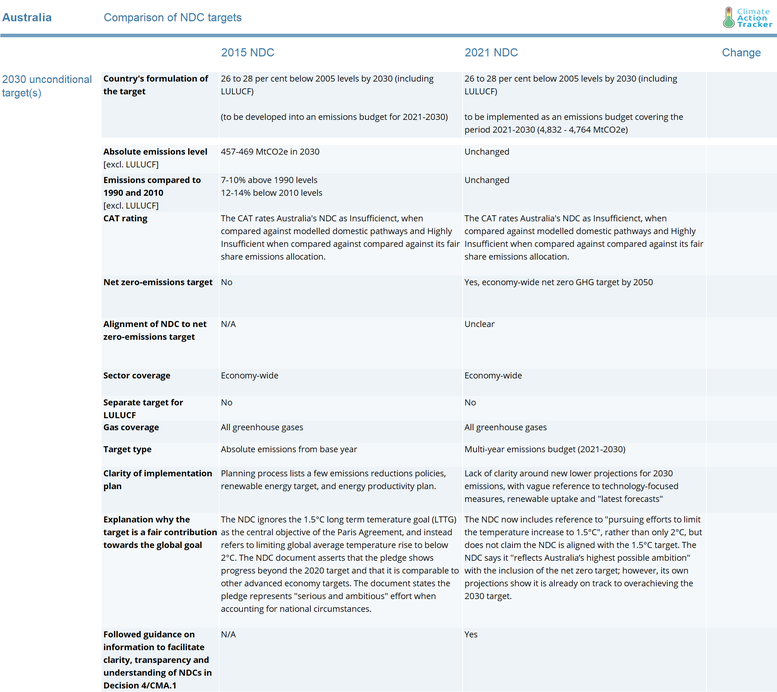CAT Climate Target Update Tracker
Australia
Summary
See here for the latest analysis on Australia's new target (August 2022).
Australia submitted its updated NDC in October 2021. The update recommunicated Australia’s unchanged 2030 target it first submitted in 2015. The CAT rates this target as 'Highly insufficient' when compared to its fair-share emissions allocation and 'Insufficient' when compared to the emissions cuts that need to occur within Australia's borders.
The resubmission includes a claim that Australia will exceed this target by up to 9%. The Paris Agreement requires countries to increase their ambition with each update: claiming that you will overachieve your target without actually committing to a stronger target doesn’t cut it.
The NDC update also puts forward a target to reach net zero emissions by 2050. An assessment of this target will be available shortly on Australia’s net zero tab.
CAT analysis of NDC


Australia submitted its updated NDC to the UNFCCC on 28 October 2021. The update did not increase the ambition of Australia’s mitigation target, despite requirements under the Paris Agreement for countries to increase ambition with each update.
The NDC update reiterates the old target, to reduce emissions by 26-28% below 2005 levels by 2030 including LULUCF. This translates to 11-13% below 2005 by 2030 excluding LULUCF, or an absolute emissions level of 465 to 478 MtCO2e1 by 2030 excluding LULUCF.
The NDC update reconfirms that a budget approach from 2021-2030 will be used, with the budget defined by a linear reduction from the 5% reduction target from 2000 emission levels for 2020. The update does not include further supporting targets, despite the fact its 2020 renewable energy target, included in the previous NDC, has expired.
The government’s new 2021 baseline emission projections indicate they are on track to reduce emissions by 30% from 2005 levels by 2030, 2% above the lower bound of its target. The government’s projections also include a high technology scenario for which no details are provided, which shows a 38% reduction, exceeding the lower bound of their NDC target by 10%, including LULUCF.
The government’s baseline projections excluding LULUCF emissions show current policies are on track to reaching 15% below 2005 level just above the lower bound of the NDC range excluding LULUCF emissions.
The updated NDC claims the lower projections are the result of new technology-focused emission reduction measures in the 2020-2021 budget and, the uptake of renewables and latest forecasts. Quantitative analysis of the government’s projections indicates this is not the case, with the main sources of emission reductions deriving from the increasing penetration of renewables in the power sector, which the government is attempting to slow down.
Furthermore, it bears repeating that suggesting you will overachieve your targets is not equivalent to submitting a stronger target to which you agree to be bound.
The updated NDC states Australia is on track to “meet and beat” the reiterated target without relying on Kyoto carryover credits (“past overachievement”), though the updated NDC does not rule out using carryover credits in the future. However, carryover units were not a credible option as other countries have rejected using this.
In the updated NDC, Australia commits to achieving net zero emissions by 2050, reiterated in Australia’s Long-term Strategy (LTS). Overall, the LTS relies heavily on the future development of low-emissions technology, along with land use reductions and international offsets, with no plans to phase out coal, curb fossil fuel exports, or hold heavy polluters accountable. Further analysis of Australia’s net zero emissions will be available shortly here.
1 | To be relevant to national context we have used government values using AR5, but for comparability with other CAT countries AR4 values are 457 to 469 MtCO2e excl. LULUCF.
Assumptions
Global Warming Potentials
Australia’s update NDC uses global warming potentials (GWPs) from the IPCC’s Fifth Assessment Report (AR5). To be relevant to national context we have used government values using AR5, but for comparability with other CAT countries, the AR4 values for the 2030 NDC are 457 to 469 MtCO2e excl. LULUCF.
LULUCF
Emissions from LULUCF were excluded in our analysis, using government projections resulting in an assumed emissions sink of 16 MtCO2 in 2030.
Links
Stay informed
Subscribe to our newsletter
